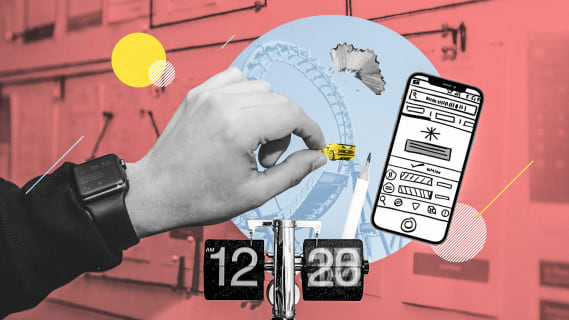Meet the Scaling team at Boldare
What is the goal of Boldare’s Scaling team? What kind of duties do team members have? Learn more about scaling from this conversation with Kamil Walkowicz – NodeJS Developer and member of the Scaling team.

Table of contents
Hi Kamil! What exactly do you do at Boldare?
My role is software development. I create and develop digital products in the Scaling team and have a secretarial role too (organizing meetings for people in the circle, taking notes, making sure events are transparent). I’ve been working as a developer for four years and in Boldare for a year and a half. I specialize in the Backend, Node.js and Typescript technologies.
The process of building products at Boldare is divided into phases within the overall “Full Cycle Product Development” process. Could you describe these phases and tell us what is the difference between them?
In the FCPD model, we specify four phases: prototype, MVP, PMF and scaling. The division into these phases results from the business needs – namely, the constant validation of whether the product meets the users’ needs. With FCPD, we better meet these needs and verify whether our assumptions about user needs are correct.
A prototype is the first phase of the cycle where developers focus on the first version of the solution, in business terms. It doesn’t have to be an application or a website. A prototype can be any way of presenting an idea for solving a given problem, e.g., research on a selected group of users or a presentation.
If we manage to confirm the assumed assumptions, we can move to the next phase, MVP. With an MVP, we deliver a product we can present to the user, with the minimum effort and cost. We verify that our idea solves a specific problem. An MVP is the first phase of marketing – we want to present the results of our work in the first advertising materials. If we go in the right direction and our assumptions become validated, we move to the next stage.
The next stage is PMF, or product-market fit. Here, we aim to match the product more closely to the market. We develop the solution into a whole product for release – the product becomes mature, and users can use it as intended. We tweak the application and its functionality to make sure it is profitable.
The last phase is scaling. This phase involves refactoring the code and developing the product to accommodate an increasing number of users and interactions. This stage of development aims at increasing market share or moving the app to new markets. We work on a mature and functioning product. However, bearing in mind its holistic development, we also improve smaller features that are part of the whole. Working on such features requires applying the other three phases of the FCPD. That is why scaling is such a complex phase – because it includes the previous three.
Why does Boldare use Full Cycle Product Development, and what value does it bring to the team and the client?
Many businesses bite off more than they can chew and invest all their resources in a single solution. It is only when the product is released to users that the client finds out whether there will be any return on that investment. Operating with FCPD, we regularly review whether the business idea has validity in the market and whether the product will hold up financially. Regularly adjusting the development of the application allows us to adapt it more closely to users’ needs. Thanks to this approach, we drastically reduce the risk of throwing money down the drain. That’s the great value that FCPD gives to the client.
Additionally, the client is guaranteed that the product will be developed by a team with the appropriate knowledge, skills, and mindset to execute this phase effectively. That’s because the FCPD phase breakdown allows different people to work in their desired environment. Some people like to change context frequently – they look for dynamics in their work and prefer to change between products. Others look for a different kind of challenge – they need to work on more long-term and complex solutions. The type of approach is also connected with the tools developers use. In Boldare, we have three circles that match the programmer with the right team and environment. The developer then does not waste their potential, and this potential is optimally used for the benefit of product development and, consequently, the client. In this way, both the client and the team benefit.
What is the main goal of the Scaling team?
To start with, let’s dispel a myth. Working in scaling is not only for developers who like to tinker with code and perform optimizations. There are three phases in the Scaling team, so we also need developers who can deliver code quickly and at a low cost. We need the MVP mindset, but not for the whole product, just for specific features.
From a business perspective, working in this circle does not necessarily mean developing and optimizing the same code base. Sometimes, in order to prepare an application for more users, it is necessary to rewrite it for new technology. This is what happened in the product I am currently working on. We decided to abandon the current code base of the product and create it from scratch (from a technology perspective, of course, we already had knowledge of the domain and the problems we were facing).
In short, scaling is a fast-paced, high-speed job. The business goal is to prepare the product for new users, eliminate bugs, prepare it for a new market or eliminate outdated elements.
How does this team differ from the others?
The Scaling team is for people who, regardless of whether they prefer fast code delivery or digging around in the code base, like to think things through. They are not afraid of meetings and brainstorming. They look for the best solutions that meet user needs and solve problems. Here, people who like to focus on deep conceptual work will feel good.
What do you like the most about working on scaling?
In the beginning, I wasn’t fond of scaling meetings, I would lose focus (even if the topic was interesting) and want to go back to the code. It has changed a lot. I like the meetings and discussions, and my main driver in scaling is problem-solving. I love the moment when we think about something, and suddenly the solution appears in our head – eureka!
What have you learned recently in scaling?
We recently did quite a pivot in the product I work for. In consequence, I had to assimilate a new technology quickly. Personally speaking, it was a pleasant experience for me. I like stepping outside my comfort zone and learning new things.
And what are the biggest challenges that the Scaling team faces?
We deal with determined clients who already know their products well and have realistic expectations. Working with large organizations that have been on the market for years and have been developing a product for a long time is different from working with clients who want to implement a fresh idea. The developer comes to such a product with zero knowledge of the solution and needs intensive onboarding. The client starts from a more informed position, which is quite a challenge.
Who would be a fit for this team, and who wouldn’t?
People who want to dig into a product and deal with optimization certainly fit into the Scaling circle. However, it’s not as if we don’t also sometimes need to deliver something fast in product scaling. Of all the product-building phases, scaling needs a business mindset the most. There is a need for versatile professionals on this team. While improving individual features, you have to deal with all other phases of FCPD — so (in a sense) you have to be suitable for them too.
Anyone who wants to change context often and focus on speed of delivery instead of quality will not feel comfortable in this circle. People who do not care about testing and performance will not find scaling a fit either. Also, we need to be able to explain to the client in a constructive, respectful way that a different path forward may be better than the one they are currently following. It takes courage to do this. The person working with us must not be afraid of confrontation.
And the last question. What would you advise those who want to join the Scaling team?
I would advise them to work on versatility. Adapting to different phases of product development are essential here. At the same time, build your knowledge of particular technologies. Specializing in a specific technological domain and developing in your chosen direction are ways to succeed in scaling.
Thank you for all your answers!
Share this article:







